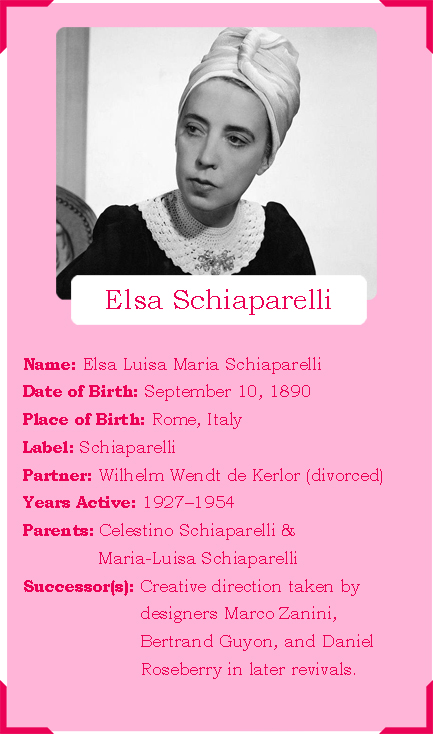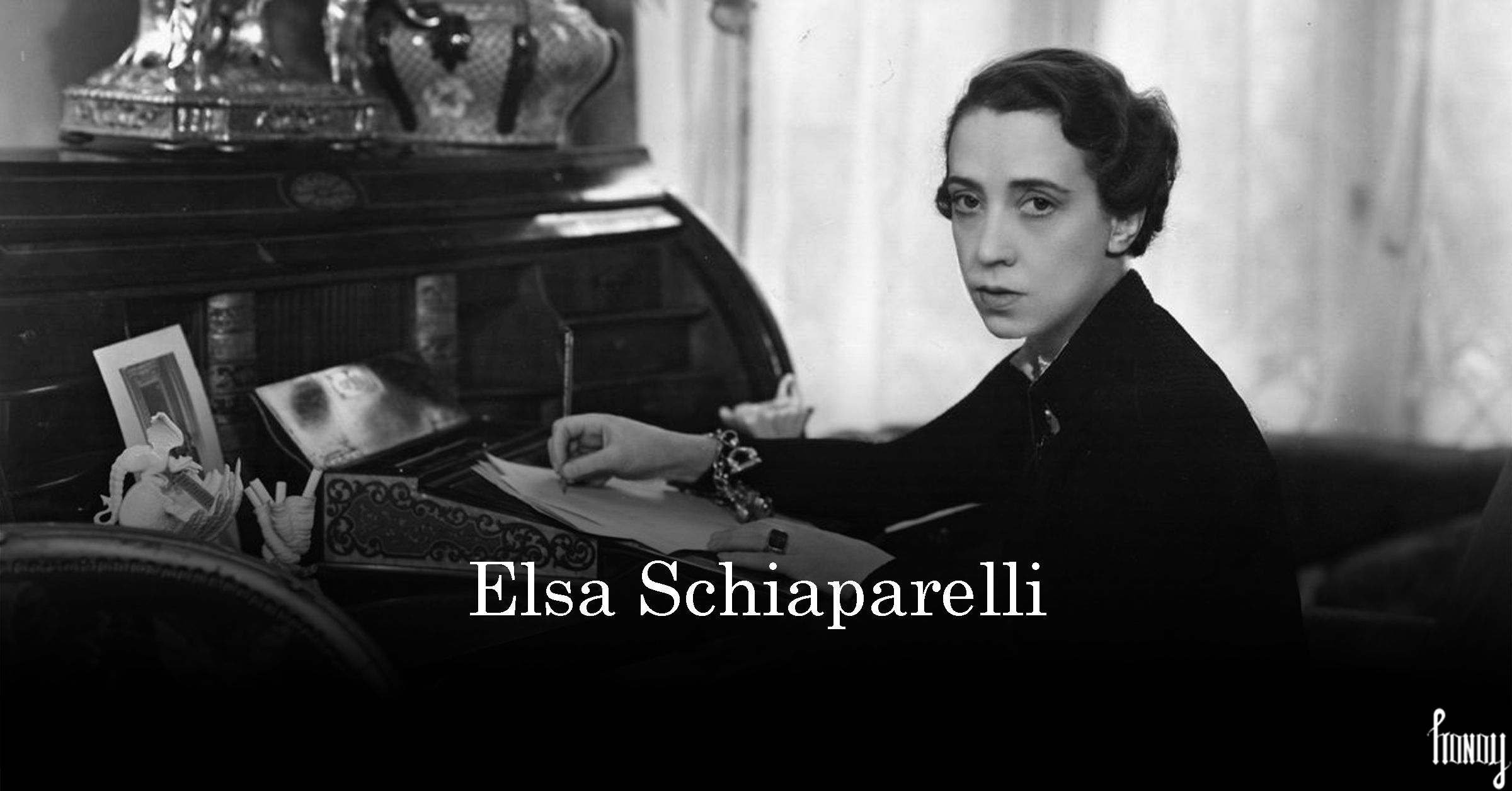Introduction

Elsa Schiaparelli, a name that resonates with surrealism and avant-garde fashion, was one of the most innovative and influential designers of the early 20th century. Known for her unconventional designs, Schiaparelli once famously said,
“In difficult times, fashion is always outrageous.”
This belief drove her to create bold, experimental pieces that challenged the norms of the fashion industry. Schiaparelli’s impact on fashion is profound, as she introduced the world to a new dimension of creativity, blending art and design in ways that had never been seen before. This blog will explore the life and creativity of Elsa Schiaparelli.
Early Life and Background
Elsa Schiaparelli was born on September 10, 1890, in Rome, Italy, into a wealthy and intellectual family. Her father, Celestino Schiaparelli, was a renowned scholar specializing in Arabic culture, while her uncle, Giovanni Schiaparelli, was a famous astronomer who discovered the canals of Mars. Growing up in such an intellectually stimulating environment, Elsa was exposed to art, literature, and science from an early age, which fueled her imagination and curiosity.
Despite her privileged upbringing, Elsa often felt out of place and struggled to fit in. She was sent to a Catholic convent school but rebelled against its strict rules. Her early love for art and poetry led her to write a collection of sensual poems, which scandalized her family and resulted in her being sent to a boarding school in Switzerland. She later studied philosophy at the University of Rome, but her restless spirit drove her to seek adventure beyond the confines of academia.
Career Beginnings

Elsa’s journey into the fashion world began almost by accident. After a failed marriage to Count Wilhelm Wendt de Kerlor, a theosophist, she moved to Paris in the 1920s with her young daughter. In Paris, she became acquainted with members of the Dada and Surrealist movements, including Marcel Duchamp and Man Ray. These artists profoundly influenced her thinking and creativity, steering her toward a career in fashion.
In 1927, Schiaparelli launched her first collection, a series of hand-knitted sweaters featuring unique trompe-l’œil designs. One of her earliest designs, a black sweater with a white bow knitted into the fabric, caught the attention of the American market when it was featured in Vogue. This design was a hit, and it established Schiaparelli as a name to watch in the fashion world.
Rise to Fame
Schiaparelli’s rise to fame was marked by a series of groundbreaking collections that defied traditional fashion conventions. In the 1930s, she introduced the concept of “shocking pink,” a vibrant magenta that became her signature color. Her 1935 “Circus” collection was a spectacle of colors and whimsical motifs, featuring acrobats, clowns, and animals embroidered on garments. This collection was widely celebrated for its originality and playfulness.
Her collaborations with Surrealist artist Salvador Dalí were particularly noteworthy. Together, they created some of the most iconic fashion pieces of the 20th century, including the Lobster Dress (1937), featuring a large lobster print that spanned the front of a white evening gown, and the Skeleton Dress (1938), which used quilting to create a three-dimensional effect resembling a human skeleton. These collaborations blurred the lines between fashion and art, making Schiaparelli a pioneer in wearable art.
Schiaparelli’s innovative approach did not go unnoticed, and she received numerous accolades throughout her career. In 1934, she was the first female designer to be featured on the cover of Time magazine, a testament to her growing influence in the fashion industry.
Signature Style and Innovations
Elsa Schiaparelli’s signature style was defined by her love for bold colors, surrealist motifs, and innovative techniques. She often used unexpected materials, such as clear plastic and metallic fabrics, and incorporated unconventional elements like zippers as decorative features. Her designs were characterized by their playfulness, wit, and a touch of the absurd.
Schiaparelli was also a pioneer in creating themed collections, each telling a story or exploring a particular concept. Her “Pagan Collection” (1938), for example, featured dresses with prints of flowers and insects, inspired by nature and the Renaissance. The “Music Collection” (1939) included dresses adorned with musical notes and sheet music motifs.
One of Schiaparelli’s most iconic contributions to fashion was the use of surrealist elements. Her collaboration with Salvador Dalí on the Lobster Dress, the Skeleton Dress, and the Shoe Hat (a hat shaped like a high-heeled shoe) are prime examples of her innovative thinking. These pieces were not just garments but artistic statements, challenging perceptions of fashion and its role in society.
Impact on the Fashion Industry
Elsa Schiaparelli’s influence on the fashion industry is undeniable. She was a trailblazer who introduced the world to the idea that fashion could be an art form. Her fearless approach to design inspired countless designers to push boundaries and think outside the box. Schiaparelli’s use of bright colors, especially her signature shocking pink, set trends and influenced the color palettes of future fashion collections.
Schiaparelli also played a significant role in elevating the status of fashion designers. By collaborating with artists like Dalí, Jean Cocteau, and Christian Bérard, she brought a level of intellectualism and artistic credibility to the field of fashion design. Her work laid the foundation for future collaborations between fashion designers and artists, a practice that continues to this day.
Notable Collaborations and Projects
Throughout her career, Elsa Schiaparelli collaborated with some of the most influential artists of her time. Her partnership with Salvador Dalí was perhaps the most famous, resulting in iconic pieces that are still celebrated today. She also worked with Jean Cocteau, whose drawings were translated into embroidery on Schiaparelli’s garments, such as the 1937 evening coat with a depiction of two faces and a vase of roses.
Schiaparelli’s involvement in costume design extended to the film industry as well. She designed costumes for several films, including Moulin Rouge (1952), showcasing her versatility and ability to adapt her avant-garde style to different mediums.
Personal Life and Public Persona
Elsa Schiaparelli was known for her eccentric personality and flamboyant style. She lived a life as colorful and unconventional as her designs. Despite the challenges she faced, including a difficult marriage and financial struggles, Schiaparelli remained a resilient and independent woman, qualities that were reflected in her work.
Her public persona was one of sophistication and wit, and she was often seen at social events and parties. Schiaparelli was known for her sharp sense of humor and her ability to charm those around her. She was well-liked and respected by her peers, including her rival, Coco Chanel, with whom she shared a love-hate relationship.
Legacy and Continuing Influence
Elsa Schiaparelli’s legacy continues to influence the fashion world. Her fearless approach to design and her ability to blend fashion with art set a precedent that many designers still follow. Schiaparelli’s use of bold colors, surrealist elements, and unconventional materials paved the way for future generations to explore new creative possibilities.
After closing her fashion house in 1954, Schiaparelli’s brand remained dormant for decades. However, it was revived in 2007, and in 2012, Italian entrepreneur Diego Della Valle acquired the brand, breathing new life into it. Under the creative direction of designers like Marco Zanini and Bertrand Guyon, the house of Schiaparelli has embraced its founder’s legacy, creating collections that reflect her spirit of innovation and audacity.
Conclusion
Elsa Schiaparelli was a visionary who redefined the boundaries of fashion. Her bold designs, innovative techniques, and collaborations with artists set her apart as a true pioneer in the industry. Schiaparelli’s influence extends beyond fashion, touching the realms of art, culture, and society. Her legacy lives on through her brand, which continues to inspire and captivate the fashion world. Exploring Schiaparelli’s collections is to witness the magic of a designer who dared to be different and changed the course of fashion history. Do let us know how you feel about the life and creations of Elsa Schiaparelli.





























Pingback: 8 Most Popular Fashion Feuds In History